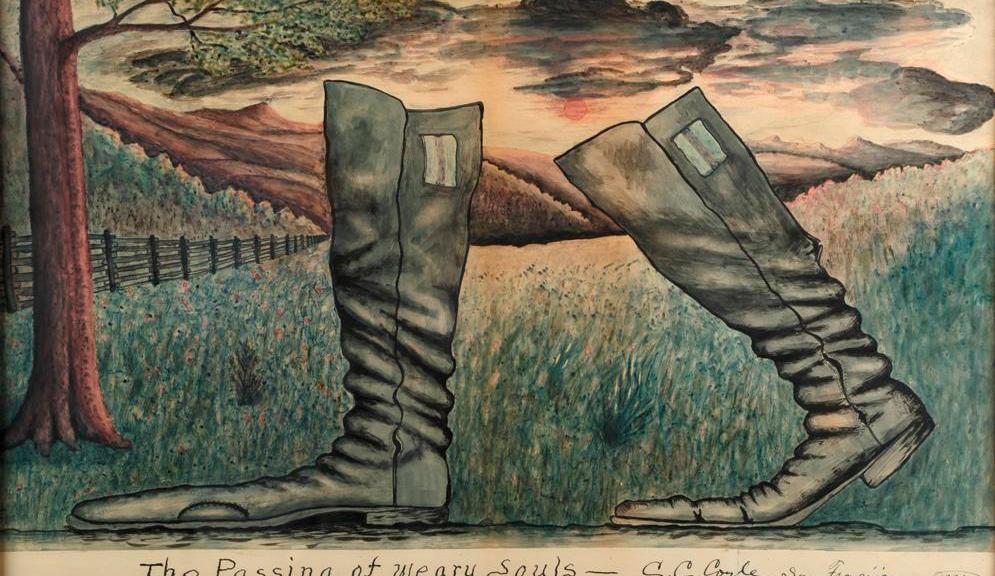In The Passing of Weary Souls (pictured above), 1921, a pair of black boots, set in stride, dominate the image. The boots are animated, but no person wears them. As though anyone might be walking in those shoes across the landscape, this painting is about a journey. Emerging from the storage of the collection of Berea College to the walls of the Kentucky Museum of Art and Craft, C.C. Coyle’s paintings are a moral journey through American life as told by a self-taught Kentucky country man.
Coyle’s paintings tell the stories of America through the land, family, history, and imagination. In many paintings, Coyle depicts the quintessential scenes of the American landscape. The expertly composed Yosemite, Bridal Veil, Nevada, and Vernal Falls, 1935, depicts the four great falls of Yosemite National Park. He also painted the famed Mariposa giant sequoia tree of southern Yosemite and Red Rock Canyon of the Painted Desert. During the late 19th and early twentieth centuries, Americans gained access to and protected these national treasures through the establishment of National Parks. Coyle painted these scenes in person, and occasionally through photographs. His landscape paintings echo the words of famed environmental advocate John Muir (1838-1914), whose tireless work led to the protection of the Sierra Nevada, when he stated in Yosemite, 1912, “Everybody needs beauty as well as bread, places to play in and pray in, where nature may heal and give strength to body and soul alike.”
The falls of Yosemite appear again in the grand painting entitled The Hand that Rocks the Cradle Rules the World, 1935. This painting best illustrates Coyle’s sense of narrative as parable. Like a moral story, the painting is an illustration of the American dream and the value of motherhood. Coyle provides a rich description of this painting in his diary, stating, “I am giving this picture to the public believing that every great man or woman had for their background the training of a good mother. It has been said that many of our great men owe their crown of glory to a good wife. That takes us right back to the mother again. This wife got her training from a good mother. Of course we must make some allowance for a fertile brain; even a fertile brain can be ruined if it does not get the proper training and support.” Thus, the good mother rests near a cabin, representing a schoolhouse, surrounded by her four children at various stages of need and independence. It is clear that her good deeds lead great men to the innovations of technology and the pages of history contained on the right side of the canvas, from aircrafts and railroads, to memorials and the White House. A sweeping epic of generations, the story unravels across the canvas, floating on dream-like clouds.

In all of these paintings, and in the words of Coyle’s diary, there is an earnesty to his call for moral fortitude and the American spirit. Although Coyle might be considered a folk artist because he was not traditionally trained, his deliberately planned, studied, carefully executed and sophisticated painting style reveals a body of work that is far more complex and cohesive than might be imagined for a naïve artist. While some research has been done on the biography and interpretation of his works, there is great potential to reveal a rich tapestry of American life.
-Eileen Yanoviak has been selected by KMAC as the incoming University of Louisville Hite Art Institute Fellow for 2013-2014.


